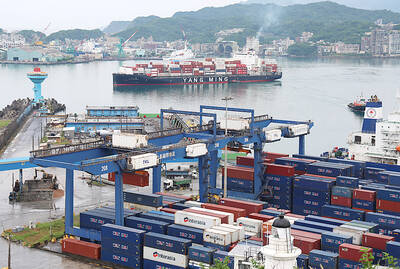For more than 50 years, a manually operated turntable ferry in rural Scotland has transported passengers between the mainland and the Isle of Skye, one of the last ferries of its kind in the world.
About 35,000 tourists take the MV Glenachulish from April to October each year, some spotting eagles or seals on the scenic route over the Kyle Rhea strait to the famed beauty spot.
However, this year, the ferry, built in 1969, is unlikely to sail due to lockdown restrictions amid the COVID-19 pandemic, raising fears over the future of the ferry — which became a community interest company in 2007 — and surrounding businesses.
“As a very little community, which is economically fragile already, this is a major hit for us,” said Jo Crawford, who runs the ferry as a social enterprise from Glenelg village, 305km northwest of Edinburgh.
“It has a massive knock-on effect for local businesses, accommodation providers, holiday homes, the shop, the cafe in the village — all of these businesses are really dependent on the visitors who come to use the ferry,” she said.
The isolation of the Scottish Highlands and Islands means the region has been relatively shielded from the novel coronavirus, but it is feeling the full force of the economic headwinds.
Without major hospitals within easy reach and an aging population, locals are nervous about outsiders traveling to the area in case they spread the coronavirus — even though their livelihoods depend on tourism.
The village of Glenelg has a full-time population of about 200 and the surrounding district is home to about 1,000 people.
“We are dependent on people coming, but it is too soon [for our] safety — we want to make sure we have a crew next year,” Crawford told the Thomson Reuters Foundation, adding that by the time restrictions are lifted, it might be too late to sail this year.
The region’s northerly latitude and climate means that tourism is restricted to a seven-month season that usually begins in March — the month Britain’s lockdown measures were introduced.
At the peak of the tourist season, the six-car ferry makes about 30 crossings per day and employs 14 workers who push and pull the vessel across the currents of the strait to a giant turntable, where it turns to make the journey back again.
However, this year the vessel remains docked in a nearby shipyard, where it is maintained over the winter months.
In a good year, the business makes enough money to subsidize travel for locals and cover maintenance costs over winter.
However, with no tourists in sight, it has turned to grants and loans to tide it over this year and even before the lockdown started turned to crowdfunding to raise more than £10,000 (US$12,168) for repairs.
“Most seasonal businesses don’t have that much in the bank. For a small business like ours, with no way of making income over the winter, it’s really difficult,” Crawford said.
The predicament is felt by social enterprises in the tourism sector globally, which have made it their mission to support their local communities through sustainable business.
Tourism makes up about 5 percent of Scotland’s GDP, with more than 15.5 million overnight tourists in 2018 spending £5.1 billion, government data showed.
It is also home to a growing social enterprise economy, with about 6,000 social enterprises employing 88,300 people.
One-fifth of these businesses are clustered in the Highlands and Islands, an area that received about 9.3 million overnight tourists in 2018, the data showed.
“Wealth generation isn’t on [social enterprises’] agenda, so as a result they might not have built up cash reserves and that makes them vulnerable,” said David Bryan, a hub manager at Social Enterprise Academy, a training program.
While charities have been able get support from funders in this period, many social enterprises have fallen through the cracks, he said.
“Those organizations that have taken an enterprising approach, tried to generate their own income stream selling products and services, paradoxically they are more vulnerable to the situation,” Bryan said.
However, it is not just local social enterprises directly linked to tourism that are struggling in the region.
“Even the industries you might not think of as tourism industries have usually got links to tourism,” Bryan said.
About 200km south of Glenelg, at the start of the Western Highlands, lies Oban, a pretty port town popular with tourists for its seafood and crossings to neighboring islands.
With a population of 8,500 that triples in the summer months, it would be “incredibly challenging for the area with most of this season lost,” said Neil Matheson, who is chairman of Atlantis Leisure, a local social enterprise sports center.
“Tourism is massive for us. The center is for the local community, but we rely on visitors’ money coming through the summer when a lot of our locals are out,” said Matheson, who also runs a shop and furniture store in the town.
Having closed on March 23 and furloughed 52 of its 55 staff, Matheson said that the sports center, which reinvests any profits it makes into the business, would have to completely rethink how it operates if it reopens with social distancing measures in place.
“Everything we do has been stood on its head with this virus, because we are trying to create a community space where groups get together,” Matheson said.
“We need to start going back to scratch again and start to envisage building a brand new business,” he said.
On the upside, for those businesses able to weather the crisis, the following year could prove to be a bumper one, with domestic tourism expected to recover first and fastest.
“[Travel] is likely to be car-borne and in Scotland 74 percent of touring is by private car,” said John Lennon, director of the Moffat Centre for Tourism at Glasgow Caledonian University.
“People are thinking and talking of holidays and big wide spaces, which we have a lot of in Scotland,” he added.

CHIP RACE: Three years of overbroad export controls drove foreign competitors to pursue their own AI chips, and ‘cost US taxpayers billions of dollars,’ Nvidia said China has figured out the US strategy for allowing it to buy Nvidia Corp’s H200s and is rejecting the artificial intelligence (AI) chip in favor of domestically developed semiconductors, White House AI adviser David Sacks said, citing news reports. US President Donald Trump on Monday said that he would allow shipments of Nvidia’s H200 chips to China, part of an administration effort backed by Sacks to challenge Chinese tech champions such as Huawei Technologies Co (華為) by bringing US competition to their home market. On Friday, Sacks signaled that he was uncertain about whether that approach would work. “They’re rejecting our chips,” Sacks

Taiwan’s exports soared 56 percent year-on-year to an all-time high of US$64.05 billion last month, propelled by surging global demand for artificial intelligence (AI), high-performance computing and cloud service infrastructure, the Ministry of Finance said yesterday. Department of Statistics Director-General Beatrice Tsai (蔡美娜) called the figure an unexpected upside surprise, citing a wave of technology orders from overseas customers alongside the usual year-end shopping season for technology products. Growth is likely to remain strong this month, she said, projecting a 40 percent to 45 percent expansion on an annual basis. The outperformance could prompt the Directorate-General of Budget, Accounting and

NATIONAL SECURITY: Intel’s testing of ACM tools despite US government control ‘highlights egregious gaps in US technology protection policies,’ a former official said Chipmaker Intel Corp has tested chipmaking tools this year from a toolmaker with deep roots in China and two overseas units that were targeted by US sanctions, according to two sources with direct knowledge of the matter. Intel, which fended off calls for its CEO’s resignation from US President Donald Trump in August over his alleged ties to China, got the tools from ACM Research Inc, a Fremont, California-based producer of chipmaking equipment. Two of ACM’s units, based in Shanghai and South Korea, were among a number of firms barred last year from receiving US technology over claims they have

BARRIERS: Gudeng’s chairman said it was unlikely that the US could replicate Taiwan’s science parks in Arizona, given its strict immigration policies and cultural differences Gudeng Precision Industrial Co (家登), which supplies wafer pods to the world’s major semiconductor firms, yesterday said it is in no rush to set up production in the US due to high costs. The company supplies its customers through a warehouse in Arizona jointly operated by TSS Holdings Ltd (德鑫控股), a joint holding of Gudeng and 17 Taiwanese firms in the semiconductor supply chain, including specialty plastic compounds producer Nytex Composites Co (耐特) and automated material handling system supplier Symtek Automation Asia Co (迅得). While the company has long been exploring the feasibility of setting up production in the US to address